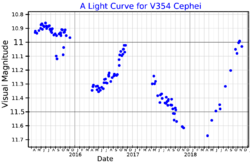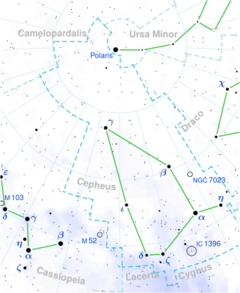Astronomy:V354 Cephei
| Observation data Equinox J2000.0]] (ICRS) | |
|---|---|
| Constellation | Cepheus |
| Right ascension | 22h 33m 34.636s[1] |
| Declination | +58° 53′ 47.12″[1] |
| Apparent magnitude (V) | 10.82 to 11.35[2] |
| Characteristics | |
| Spectral type | M2.5 Iab[3] – M3.5 Ib[4] |
| B−V color index | +3.18[5] |
| Variable type | Lc[2] |
| Astrometry | |
| Proper motion (μ) | RA: –3.151[1] mas/yr Dec.: –2.398[1] mas/yr |
| Parallax (π) | 0.2161 ± 0.0388[1] mas |
| Distance | approx. 15,000 ly (approx. 4,600 pc) |
| Details | |
| Mass | 3.61[6] M☉ |
| Radius | 685[7] R☉ |
| Luminosity | 71,000[7] - 76,000[8] L☉ |
| Surface gravity (log g) | –0.5[5] cgs |
| Temperature | 3,615±170[7] K |
| Other designations | |
| Database references | |
| SIMBAD | data |
V354 Cephei is a red supergiant star located within the Milky Way. It is an irregular variable located over 8,900 light-years away from the Sun. It has an estimated radius of 685 solar radii (477,000,000 km; 3.19 astronomical unit|au). If it were placed in the center of the Solar System, it would extend to between the orbits of Mars and Jupiter.
Identification
V354 Cephei is identified as a red supergiant variable star and included on surveys such as IRAS and 2MASS, but prior to its inclusion in the General Catalogue of Variable Stars in 1981, it was referred to only by its listings on relatively obscure catalogs.[9] It is too faint to be included in catalogs such as the Henry Draper Catalogue or Bonner Durchmusterung. It was included on a 1947 Dearborn Observatory survey as star 41575, but that ID is hardly ever used.[10]
V354 Cephei has been referred to as Case 75.[5][9] This is from one of several listings of cool stars made using the Burrell Schmidt telescope at the Warner and Swasey Observatory of Case Western Reserve University, although Case 75 is mistakenly identified as the nearby F3V star BD+58°2450.[11] The carbon star AT Persei is listed as star 75 in another of the survey papers and is also known as Case 75. The SIMBAD astronomical portal prefers to restrict that usage to AT Persei and has devised a different unique acronym for V354 Cephei.[12]
Distance

V354 Cephei is near the Cepheus OB1 stellar association and considered a likely member. This association is at a distance of between 2,750 and 3,500 parsecs,[8][13][lower-alpha 1] but currently thought to be at 3,400 parsecs based on reliable Gaia Data Release 2 parallaxes of neighbouring OB stars.[14] Its Gaia Data Release 2 parallax is 0.4581±0.1023 mas,[15] implying a much smaller distance of around 2,000 pc.[16] The Gaia Early Data Release 3 parallax is 0.2161±0.0388 mas, implying a larger distance. Both Gaia results carry significant statistical margin of error, as well as indicators that the astrometric excess noise is far beyond acceptable levels so that the parallax should be considered unreliable.[15][1]
Properties

The properties of V354 Cephei are disputed, but the star is classed as a cool supergiant star with a spectral and luminosity class given as M2.5 Iab, indicating it is an intermediate-size luminous supergiant, but was later given as M3.5 Ib, indicating it is rather a less luminous supergiant.[3][4]
A 2005 study led by Levesque described the four red supergiant stars, KW Sagittarii, V354 Cephei, KY Cygni and Mu Cephei as the largest and most luminous galactic red supergiants with radii of roughly 1,500 R☉ and bolometric luminosity of roughly 300,000 L☉, which is consistent with the empirical upper radius and luminosity boundary for the red supergiants. Despite it, larger sizes and luminosities have been published for few other galactic red supergiants, such as VV Cephei A and the peculiar star VY Canis Majoris at 1,200–1,900 R☉ and more than 3,000 R☉. V354 Cephei, based on a MARCS model, was found to be the largest and most luminous of these four stars measured, with a high luminosity of 369,000 L☉ and consequently very large size of 1,520 R☉ based on the assumption of an effective temperature of 3,650 K.[5]
Newer calculations of the luminosity of V354 Cep determined the luminosity of the star to be somewhat much lower, below 80,000 L☉, which implies much smaller sizes below 690 R☉.[8][7] A 2011 study notes the discrepancy but is unable to explain it.[8] There are similar differences in the visual extinctions derived, between two and six magnitudes.[3][5] Other more recent published data assumes the smaller Gaia distance, and hence derives lower luminosities.[7]
Notes
- ↑ V354 Cephei is assumed to be part of the Cep OB1 association, which has an adopted distance modulus of 12.2. See Tables 1 and 2, Levesque et al. 2005.
References
- ↑ 1.0 1.1 1.2 1.3 1.4 1.5 Brown, A. G. A. (2021). "Gaia Early Data Release 3: Summary of the contents and survey properties". Astronomy & Astrophysics 649: A1. doi:10.1051/0004-6361/202039657. Bibcode: 2021A&A...649A...1G. Gaia EDR3 record for this source at VizieR.
- ↑ 2.0 2.1 "V354 Cep, database entry". The combined table of GCVS Vols I-III and NL 67-78 with improved coordinates, General Catalogue of Variable Stars. Moscow, Russia: Sternberg Astronomical Institute. http://www.sai.msu.su/groups/cluster/gcvs/gcvs/iii/iii.dat.
- ↑ 3.0 3.1 3.2 Verhoelst, T.; Van Der Zypen, N.; Hony, S.; Decin, L.; Cami, J.; Eriksson, K. (2009). "The dust condensation sequence in red supergiant stars". Astronomy and Astrophysics 498 (1): 127–138. doi:10.1051/0004-6361/20079063. Bibcode: 2009A&A...498..127V.
- ↑ 4.0 4.1 Dorda, R.; Negueruela, I.; González-Fernández, C. (2018). "The red supergiant population in the Perseus arm". Monthly Notices of the Royal Astronomical Society 475 (2): 2003. doi:10.1093/mnras/stx3317. Bibcode: 2018MNRAS.475.2003D.
- ↑ 5.0 5.1 5.2 5.3 5.4 5.5 5.6 Cite error: Invalid
<ref>tag; no text was provided for refs namedrg - ↑ Anders, F.; Khalatyan, A.; Chiappini, C.; Queiroz, A. B.; Santiago, B. X.; Jordi, C.; Girardi, L.; Brown, A. G. A. et al. (2019). "Photo-astrometric distances, extinctions, and astrophysical parameters for Gaia DR2 stars brighter than G = 18". Astronomy and Astrophysics 628: A94. doi:10.1051/0004-6361/201935765. Bibcode: 2019A&A...628A..94A.
- ↑ 7.0 7.1 7.2 7.3 7.4 Messineo, M.; Brown, A. G. A. (2019). "A Catalog of Known Galactic K-M Stars of Class I Candidate Red Supergiants in Gaia DR2". The Astronomical Journal 158 (1): 20. doi:10.3847/1538-3881/ab1cbd. Bibcode: 2019AJ....158...20M.
- ↑ 8.0 8.1 8.2 8.3 Mauron, N.; Josselin, E. (2011). "The mass-loss rates of red supergiants and the de Jager prescription". Astronomy and Astrophysics 526: A156. doi:10.1051/0004-6361/201013993. Bibcode: 2011A&A...526A.156M.
- ↑ 9.0 9.1 Kholopov, P. N.; Samus', N. N.; Kukarkina, N. P.; Medvedeva, G. I.; Perova, N. B. (1981). "66th Name-List of Variable Stars". Information Bulletin on Variable Stars 2042: 1. Bibcode: 1981IBVS.2042....1K.
- ↑ Lee, O. J.; Baldwin, R. J.; Hamlin, D. W.; Bartlett, T. J.; Gore, G. D.; Baldwin, T. J. (1943). "Dearborn catalog of faint red stars : Titanium oxide stars in zones -4. 5[degrees] to +13.5[degrees]". Annals of the Dearborn Observatory of Northwestern University 5: 1. Bibcode: 1943AnDea...5....1L.
- ↑ Nassau, J. J.; Blanco, V. M.; Morgan, W. W. (1954). "Reddened Early m- and S-Type Stars Near the Galactic Equator". Astrophysical Journal 120: 478. doi:10.1086/145936. Bibcode: 1954ApJ...120..478N.
- ↑ "V354 Cephei". SIMBAD. Centre de données astronomiques de Strasbourg. http://simbad.u-strasbg.fr/simbad/sim-basic?Ident=V354+Cephei.
- ↑ Humphreys, R. M. (1978). "Studies of luminous stars in nearby galaxies. I. Supergiants and O stars in the Milky Way". Astrophysical Journal 38: 309. doi:10.1086/190559. Bibcode: 1978ApJS...38..309H.
- ↑ Parker, Richard J.; Crowther, Paul A.; Rate, Gemma (2020). "Unlocking Galactic Wolf–Rayet stars with Gaia DR2 – II. Cluster and association membership". Monthly Notices of the Royal Astronomical Society 495 (1): 1209–1226. doi:10.1093/mnras/staa1290. Bibcode: 2020MNRAS.495.1209R.
- ↑ 15.0 15.1 Brown, A. G. A. (August 2018). "Gaia Data Release 2: Summary of the contents and survey properties". Astronomy & Astrophysics 616: A1. doi:10.1051/0004-6361/201833051. Bibcode: 2018A&A...616A...1G. Gaia DR2 record for this source at VizieR.
- ↑ Bailer-Jones, C. A. L.; Rybizki, J.; Fouesneau, M.; Mantelet, G.; Andrae, R. (2018). "Estimating Distance from Parallaxes. IV. Distances to 1.33 Billion Stars in Gaia Data Release 2". The Astronomical Journal 156 (2): 58. doi:10.3847/1538-3881/aacb21. Bibcode: 2018AJ....156...58B.
- ↑ "ASAS All Star Catalogue". The All Sky Automated Survey. http://www.astrouw.edu.pl/asas/?page=aasc.
External links
 |


